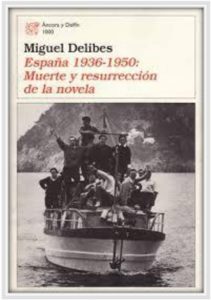The works of
Miguel Delibes
The works of
Miguel
Delibes
Hunting, fishing and nature
of Miguel Delibes
La caza de la perdiz roja
Lumen, 1963
“La caza de la perdiz roja” is a brief and delightful work published first as an independent text , with photographies of Oriol Masapons, in 1963 and afterwards incorporated to the edition of “Viejas historias de Castilla la vieja” made by Alianza Editorial in 1969.
It is written in form of a dialogue between el Barbas, an old wise partridge hunter, and the Hunter, Figure of Delibes himself, and all along the dialogues they reflect and comment about hunting but at the same time there is a clear complaint about the abusive practice of hunting and the progressive extinction of the free hunting.
There are plenty of critics and worries in this work, about the ecological imbalance and how it got broken up and its consequences over the hunting practice, these worries will end up being a constant theme in Delibes´ literature.
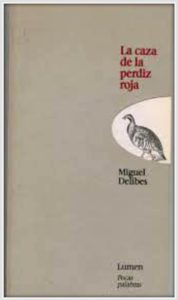
El libro de la caza menor (The book of minor hunting)
Destino, 1964
Miguel Delibes develops again in this work some of the approaches and reflections already exposed in “La caza de la perdiz roja”-1963-. In this new book abouthunting, with photographies of Francisco Ontañón, the writer chooses an essay style development whereas in “La caza de la perdiz roja” he chose a dialogue format.
Supported on the theories of Ortega y Gasset about hunting- already discussed with el Barbas in the previous book-, Delibes makes a detailed study of all the species that conform the minor hunting, paying attention to their habitat, costums and legal hunting practices. The protagonist of the book are thus the partridge, the quail, the rabbit, the hare, the dove, the duck, the fox, the great bustard, the woodcock, and the wood grouse but also the hunter whose first and last season hunting days open and close the book in both chronicles that the writer narrates with his signature mastery and subtle sense of humor.
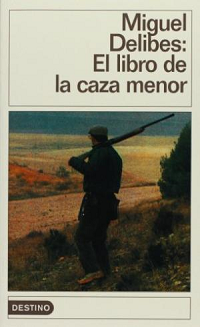
La caza en España (The hunting practice in Spain)
This work is about a collection of essays- “Laza en España”, “La nueva codorniz”, “Las tablas de Daimiel” and “La caza hace un siglo”-, some of them very breve. The first and more extense gives the title to the work, was published in 1968 as the introduction of a colective book “Alegrías de la caza”, published originally in French in 1966 and translated later on by Delibes hmself and his son Miguel. In this book Delibes talks about topics related to the hunting practice but also about ecological matters such as the preservation of the environment and the dangers of some species of the Spanish fauna.
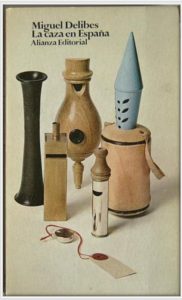
S.O.S.
Destino, 1976
With the title of S.O.S., it is edited again the joining discourse of Miguel Delibes in the Real Academia Española in 1975, which then had title of: “El sentido del progreso desde mi obra” (“The meaning of progress from my work perspective”), accompanied of two other little texts: “Prólogo a un libro sobre la caza de patos que nunca llegó a escribirse” and “La catástrofe de Doñana”.
In the speech of “El sentido del progreso desde mi obra” it is plain to see the ecological thinking and the ecological mind of the author ns his complaint of a world and a society that have turned against nature, at the same time the writer points out that there is a fake sense of progress.
Delibes also explains how all his fiction characters life in perfect harmony with the environment and they revolt against the fake progress that is destroying nature in favor of the technic and that has devastated the fields and exploited even the language of the people from the rural areas.

Aventuras, venturas y desventuras de un cazador a rabo (Adventures, fate and misfortunes of a hunter with dog)
Destino, 1977
“Aventuras, venturas y desventuras de un cazador a rabo” is this time, the real “Diary of a hunter”, real and the protagonist is Miguel Delibes himself and not a fiction diary in which the protagonist is Lorenzo.
In this work the writer-hunter writes the Preface- “that are no other but my own hunting experiences that took place between 1971 and 1974”.
Delibes goes out to the fiels with his shotgun and then he writes in his hunting notebook what happened during the day, and those event are never the same, even if they seem similar, as he also expresses in the Preface: “When I began writing in this hunting notebook, I found out something: never, even if the protagonists and the background are the same, there is never an exact hunting day, each excursion is unique due to several factors and details that are very hard to define”.
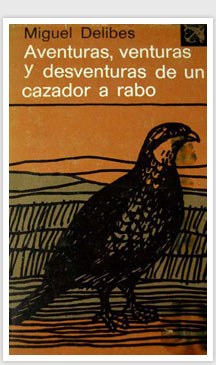
Mis amigas las truchas (The trouts, my friends)
Destino, 1977
This work that has a subtitle: “del block de notas de un pescador de rivera”, in a new diary of Delibes, but this time is about fishing and it correspond to the seasons between 1972 to 1976.
Regarding the contradictory title “The trouts, my friends”, Delibes gives an explanation in the Preface: “During some time I was doubtful of which one should I chose, but finally I decided to choose this one as a tribute to the fish that have provided me so many good times. Logically the trouts won´tshare my point of view, so it is very probable that my affection to them won´t be reciprocal. In the fishing game, they risk a lot more than me. It is then a unilateral friendship, but I wrote the book and not them and consequently I talk from my own experience.”

El mundo en la agonía (The world in agony)
Plaza&Janés, 1979
With the title “el mundo en la agonía”, it is gatheres the joining discourse of Miguel Delobes in the Real Academia Española in 1975, it has be organized in ten chapters and illustrated by José Ramón Sánchez and with a Preface of Ramón García Domínguez.
This discourse summarizes Delibes´ ecological mind and way of thinking and his complaint about a world and a society that have turned against nature and a fake sense of progress that came to warm up the society´s stomach but made its heart stone cold”.
“El sentido del progreso desde mi obra”, was indeed the title of the discourse of his joining the Real Academia Española, edited in 1976 with the title of S.O.S.”
In 1988 Círculo de Lectores publishing house published this same text but with some illustrations of the Suiss designer Celestino Piatti.
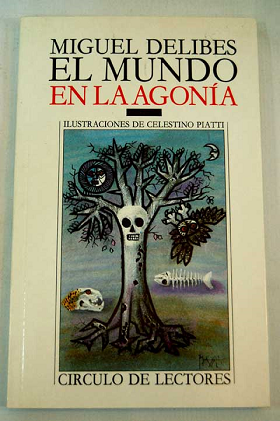
Dos días de caza (Two hunting days)
Destino, 1980
This work summarizes the first and last chapters- The first and the last day of the hunting season- “El libro de la caza menor” (1964), in this last title Delibes makes a detailed description of all the species and their habitat and at the same time he talks about the costums and traditional legal hunting practices.
Thesetwo narrations form those psychological analysis of the hunter in two specific moments- first and last day of the season- very different but equally exciting.
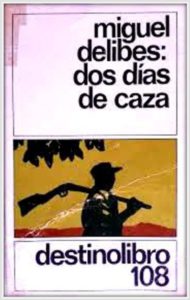
Las perdices del domingo (The Sunday partridges)
Destino, 1981
“Las perdices del domingo” is a new hunting diary which goes from August of 1974 to February of 1978, and that tells about the adventures and anecdotes, the description of the landscapes, the joy of being surrounded by nature but also the lament and complaint. Delibes takes every chance to push some bottons: “Sunday after Sunday- he writes in his “preliminary justifying”- during Fall or Winter, the hunter goes out to the fields searching the partridges, some days he is lucky and some other not, but, in any case the partridge are diminishing in number on the fields, so I can very well imagine that in a few years time, these pages will be the proof of a devastating process, due to which Castilla was depopulated of birds as it happened centuries ago with the woods.
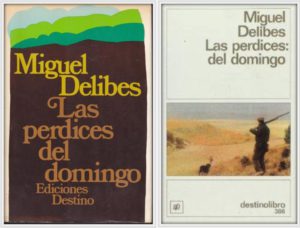
La tierra herida (Wounded land)
Destino, 2005
This work has as a subtitle “¿Qué mundo heredarán nuestros hijos?” (“What kind of world will our children inherit?”), is an extensive dialogue between the writer Miguel Delibes and his son Miguel Delibes de Castro- Phd in Biological Science- about nature and the dangers that affect it nowadays.
This is the last book published by Miguel Delibes- The wirter dies on the 12th of March of 2010- and with it he wrpas up with his endless preoccupation about the environment. This worries and complaints that he began in 1975 with his joining discurse in the Real Academia Española- “El sentido del progreso en mi obra”- reaches its peak thirty five years after with this vivid dialogue with which the writer and his son try to contribute to give a “solution”, or at least to alert people about an issue of hug dimensions”.
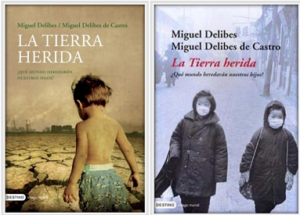
Newspaper articles
of Miguel Delibes
Vivir al día (Living for the moment)
Destino, 1968
Miguel Delibes compiles in this work a selection of articles published in several Spanish newspapers- El Norte de Castilla, La Vanguardia, Ya, Informaciones…- The articles between 1953 and 1967 are a good third part of the articles published during almost fifteen years.
The articles are organized according to a chronological order- this was a personal decition of the author- this allows to get closer to the mood of Delibes and also to his worries and ups and downs during the times of the press censorship in Spain, as the author points out on the preface.
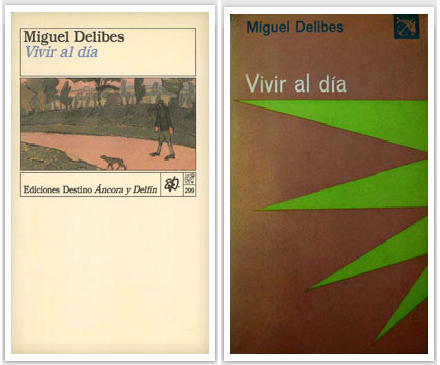
Con la escopeta al hombro (Shotgun and set off)
Destino, 1970
This work could be considered as the second part of “Libro de caza menor”, although in this part we see a more relaxed and humorous style in the author´s writing. In this way Delibes points out on the preface: “For me writing about hunting matters means getting rid in some way of the strict conditions that rule the rest of my writing pieces. If I feel free when I´m hunting, I reproduce that pleasant feeling on my lines…”
The partridges, the quails, and the hares become the true protagonists of these pages in which we observe how much Delibes enjoyed this sport although we also can see that as much he enjoyed hunting he enjoyed nature and the wonders of the landscapes and the countryside.
This work appeared in several instalments (1969-1970) in the Sunday supplement of El Norte de Castilla.
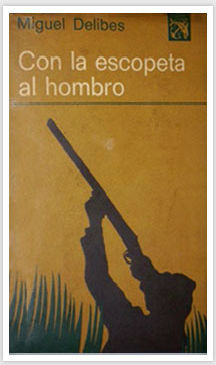
El otro fútbol (The other football)
Destino, 1982
This works compiles several articles, written in different stages, about different topics from which the most extensive onesare about fooball.
Delibes played football during his student yearsand he kept his fondness to this sport as a spectator going to the stadium to watch the games. Some years after Delibes stopped going to the stadium but he continued watching football games on TV.
In these pages Delibes gives his view and opinion about some competitions and championships as the Eurocup in 1980 or the World Cup in 1982.
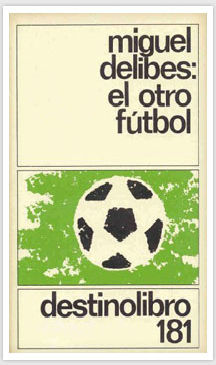
El último coto (The last hunting ground)
Destino, 1992
“Why?”, asks Delibes in the beginning of the book, well, the answer is clear, “beause the red partridge is getting wiser and more and more difficult to trace and this old hunter does not have the same strength and eagerness as he used to to walk the fields seeking his trophies and also the lands are getting less wild and more and more deforest and thus more difficult for the catch to hide and surprise”
“The last hunting ground” would be the last hunting book of Miguel Delibes, where he register his lasts hunting excursions of 1986 to 1991, but also his growing preoccupation about the nature damage and the extinction of some species. In the last lines of the book, Miguel Delibes says goodbye to his dear old friend the red partridge: “The las hunting ground accomplishes its mission and I take a bow before that red-legged beautiful bird that made me happy so many times along almost seventy years of hunting practices”.

Anthologies
of Miguel Delibes
Mi mundo y el mundo (My world and the world)
Miñon, 1970
“Mi mundo y el mundo” which has a subtitle “Antologías del autor para niños de 11 a 14 años” was published for the first time with a series of illustrations of Pedro González Collado, in the reading collection “Álvarez” of the Miñón Publishing house. The same Publishing house re-edits this work in 1981 in the collection “Las Campanas”.
The work is a selection made by Delibes himself of those aspects that could be most interesting for his readers “children´s adventures, animal stories or courious details of my trips around the world”. Each excerpt is preceded by a brief introduction of the writer in which he explains the content of the work to which it belongs to.

Castilla en mi obra (Castille in my work)
Editorial Magisterio Español, 1972
“Castilla en mi obra” This is an anthology of texts taken from several novels of the autor- “Diario de un cazador”, “Diarios de un emigrante”,”Las ratas”,”La hoja roja”, “El camino”-,several tales- “La mortaja”, “La perra”, “Viejas historias de Castilla la vieja”- and from the compilation of some press articles “Vivir al día”.
This work has illustrations of Menchu Genove, it is divides in nine chapters: “El paisaje”, “Dependencia del cielo”, “Fatalismo”, “La trágica ironía”, “El individualismo”, “Sabiduría socarrona y escepticismo”, “Soledad”, “Superchería y religiosidad elemental” and “Éxodo”.
Castilla, lo castellano y los castellanos (Castille, about Castillian things and Castillian people)
Planeta, 1979
It is about a selection of texts, made by Delibes himself, that represent the best the land and the people of his homeland Castilla.
Delibes devided this rich material in twenty chapters or topics that range from the landscape to the concept of modern progress as well as religious matters and the closeness to the land and individualism and the abandoning of the rural areas among some other.
This anthology of texts is doubtless the living proof that Delibes is the most representative writer of Castilla as well as the best judge to its situation along the XX century- not very optimistic or hopeful.
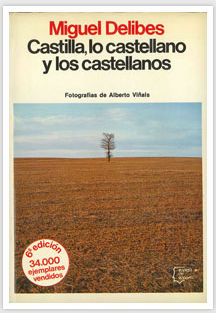
La caza de la perdiz roja en España (Hunting the red partridge in Spain)
Destino, 1988
In this anthology are collected excerpts from several Works that have the red-legged bird as a protagonist and that Delibes summarizes as follows: “One theory about the partridge (“El libro de caza menor”), the different procedures to hunt it that are taken from some of my diaries (“Aventuras, venturas y desventuras de un cazador a rabo”, “Las perdices del domingo” and “Con la escopetaal hombro”) and an early prediction about its future”.
This is a boog in a big format that includes photographs of Francesc Catalá-Roca.
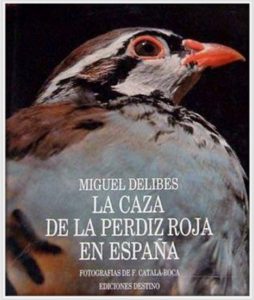
Los niños (The children)
Planeta, 1994
This anthology collects the best excerps of Delibes about childhood.
“Los niños” is a work divides in two parts: “Los niños de pueblo” (“Children from the village”) and “Niños de ciudad” (“Children from the city”). Delibes decribes childhood as a very special world that reflects somehow the world of the adults. Delibes points out: “A child is a creature that is candid and is extremely funny, and has all the doors wide open, this means that he or she can become whaterver he or she wants to, whereas a man is a child that has lost all of that candid and is not so funny and has finally focused all his opportunities only in one (the job, he has). This means that the mistery that a child holds is way bigger than that of a grown up and consequently, a story told about a child can create even more interest than one told about a grown up character.
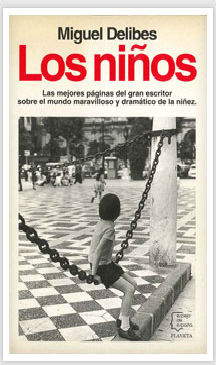
De Valladolid (From Valladolid)
Lunwerg, 2009
The anthological texts of this volume come together with plenty of photographs and it is edited in a big format, it is grouped in four parts: “My city, my province, my people”, “Resemblance”, “Memories and nostalgia” and “Narrations”. The excerpts selected by Ramón García Domínguez and Ciro García Jiménez, come from novels as well as from tales in which the author mentiones his hometown, or press articles, autobiographical books and hunting notebooks, etc…

Mis perros (My dogs)
El Pasaje de las Letras, 2009
The Preface of this work is written by Germán Delibes de Castro and illustrated by Santiago Bellido and collects a selection of texts taken from “Mi vida al aire libre (memorias deportivas de un hombre sedentario)”-1989- and “El ultimo coto”-1992-
“My dogs” is in a way an aoutobiographical tour about his dogs- la Fita, el Cóquer or el Grin- that as “good friends” accompanied Miguel Delibes along his life, in his daily walks or inhis hunting seasons.
In these texts the author describes the dog´s breeds and some of their behaviours and tells about some stories and anecdotes of his faithful friends that shared his life and also his children´s life.
The illustrations about dogs were made from photographs taken from the personal archive of the Delibes Family, which gives the reader a close view of the real characters and protagonists.

La risa de Nini y otros textos (Nini's laughter and other texts)
Bruño, 20011
This is an anthology aimed to secondary students in which there are collected tales and excerpts of several novels and other texts. (“Mi vida al ire libre”, “Tres pájaros a cuenta”, part of the acceptance discourse for the Cervantes award…)
Since this is a didactic edition, it includes a brief dictionary and some activities.
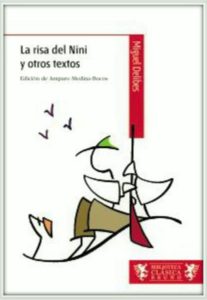
Autobiographical books
of Miguel Delibes
Un año de mi vida (A year of my life)
Destino, 1972
«Un año de mi vida»
responds to an idea of Delibes’ editor, Josep Vergés, and it started with the publication of some notes written weekly in the magazine Destino which in the end would conform this work.
During a whole year, as the title describes, Delibes registered and commented on everything that happened to hin, his routinary life. The diary starts on the 22nd of June of 1970 and ends on the 20th of June of 1971. We can find reflections about some readings, the current affairs contained in the press, trips and visits, news and family anecdotes and also- on the 17th of October of 1970- a comment about his fiftieth birthday: “ on the early hours of today I became fifty years old[…] who knew!, half a century! When you turn fourty you may think that past and present reach to a balance, but when you turn fifty the side of the past turns much more heavy. From the peak of my fifties I can already have a glimpse of death”.
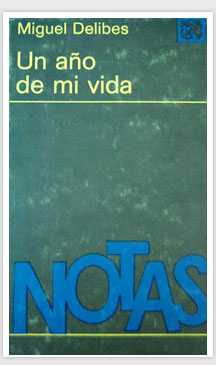
Tres pájaros de cuenta
Miñón, 1982
Delibes wrote this novel based on autobiographical experiences, and thinking of possible children readers.
The protagonists are three birds, that already appeared in some other of his books and even in some of his novels: the cuckoo, the jackdaw and the brown owl. “I used the three of the- he explains to his readersin the presentation- to create the book that you now have in your hands, it is no a book of tales or invented stories, but a book of real stories, that I lived myself and in which those birds are the true protagonists. I hope that by reading this book you won´t be indifferent and on the contrary your love and interest towards nature will grow”.
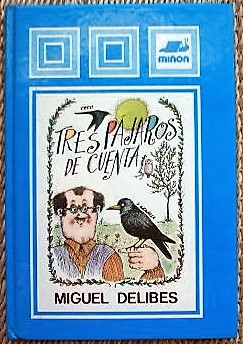
Mi vida al aire libre (My life in the fresh air)
Destino, 1989
In “Mi vida al aire libre (Memorias deportivas de un hombre sedentario)”, Delibes bring back his memories about all the sports that he has practiced along his life: from his ealy eagerness for hunting going out with his father, to his passion for football, mentioning also ciclying or motorbikes and even tennis.
These memories are told in a colloquial language and full of humorous images, although also a bit nostalgic and these aspects make it an easy and pleasant book to read, as most of the works from Delibes.
The works “Mi querida bicicleta” (“Mi dear bycicle”), “La vida sobre ruedas” (“Life on wheels”) and “Un deporte de caballeros” (“A gentelmensport”) were aimed to children readers- and they include some chapters of “Mi vida al aire libre (Memorias deportivas de un hombre sedentario)”.
«Mi querida bicicleta» (My dear bycicle)
Miñon, 1988
This work is the third chapter of the nine of which the book is conformed “Mivida al aire libre (Memorias deportivas de un hombre sedentario)”, in which Delibes recalls and tells about the different sports that he has practised along his life. In “My dear bycicle”- a book thought for the little ones- is represented his fondness for cycling.
«La vida sobre ruedas» (Life on wheels)
Destino, Col. Pequeño delfín, 1992
Destino, Col. Pequeño delfín, 1993
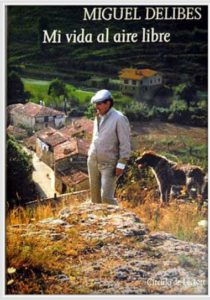
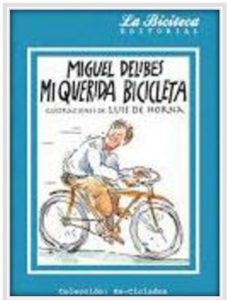


Correspondencia 1948 - 1986 (Miguel Delibes-Josep Vergés) (Collected letters 1948-1986 Miguel Delibes-Josep Vergés)
Destino, 2002
This work compiles the collectes letters between Miguel Delibes and his editor Josep Vergés (Palafrugell, 1910-Barcelona, 2001), co-funder of the magazine Destino and the Publishing house of the same name.
In the beginning Delibes disdained as a possible object of publication his letter interchange with Josep Vergés, but finally admitted that they were “not only a confrontation between a stingy catalán editor and a stingy castillian author with many children […] but the first contact between two good men united by the affection more than their personal ambitions and destined to keep a fraternal friendship along the years”.
This collection of letters, apart from being prove of the faithfulness of Delibes to his editor and the consolidation of a friendship that lasted more than fourty years, is also an intimate portrait of the social and cultural history of Spain during those years.
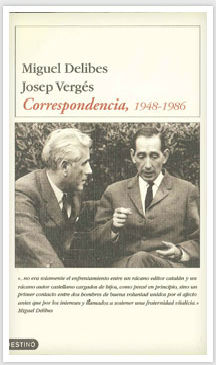
Correspondencia 1960-2009 (Miguel Delibes-Gonzalo Sobejano) (Collected letters 1960-2009 Miguel Delibes-Gonzalo Sobejano)
Edición de Amparo Medina-Bocos. Valladolid, Fundación Miguel Delibes-Universidad de Valladolid, 2014
A book of the compillation of letters exchanged between Miguel Delibes and Gonzalo Sobejano between the years 1960 ans 2009.

Travelling books
of Miguel Delibes
Un novelista descubre América (Chile en el ojo ajeno) (A novelist discovers America - Chile from somebody else's eyes)
Editorial Nacional, 1956
During the Spring of 1955, Miguel Delibes who had been invited by the Círculo de periodistas de Santiago de Chile, visits several countries of Latin America: Brasil, Uruguay, Argentina and Chile. After this trip he publishes aseries of chronicles in the magazine Destino that the following year would appear compiled in form of a book with the title: “Un novelista descubre América (Chile en el ojo ajeno)”.
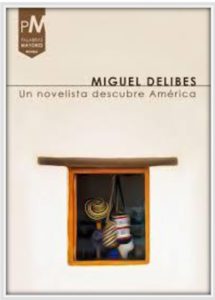
Por esos mundos (Sudamérica con escala en Canarias) (Around those places - Southamerica with a stopover in the Canary Islands)
Destino, 1961
This work includes the same travelling chronicles (Brasil, Uruguay, Argentina and Chile) as in “Un novelista descubre Ámerica (Chile en el ojo ajeno)” that was published in 1956- and it is added a new chapter, the stopover in the Canary Islands, more specifically in Teneriffe.
Miguel Delibes indicates in the preface of “Por esos mundos (Sudamérica con escala en Canarias)”: “These volumes that hereby begin are not only the usual travelling guides”. Nevertheless, Delobes maybe forgot his initital purpose, since he never put the title “Por esos mundos” to any of his travelling books.
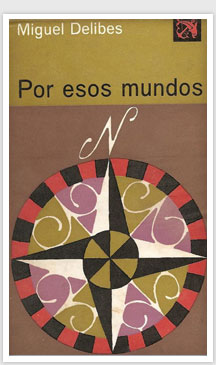
Europa: Parada y fonda (Europe: travelling stop and inn)
Ediciones Cid, 1963
To define this work nothing better than the words of the writer himself: “In Europa:parada y fonda, the traveler has only randomly picked some details about half a docen of European countries- Italy, Portugal, Germany and France- Visited in the last few years”- Those years the writer referred to are: 1956 (Italy), 1957 (Portugal), 1959 (France) and 1960 (Germany).
Delibes concludes his preface saying: “Take the words in this volume only as as a collection of brief observations about some places in some European countries, some of the observations may serve you as an encouragement to visit them, to some other people as a way to remember them, and maybe to a third group to imagine what for some or another reason they won´t be able to see”.
This book was re-edited in 1981, with an extense preliminary study of Ramón García Domínguez called “Miguel Delibes, viajero” in which he comments on the travelling philosophy of the author.

USA y yo (USA and I)
Destino, 1966
This book collects 33 chronicles or chapters in which Miguel Delibes talks about his experiences during the six months that he lived and spent at the University of Maryland working as a Professor at the Language and foreign Literatures Department in 1964.
The writer visited the states of New York, New Jersey, Connecticut, Massachussetts, Maryland, Virginia, Carolina, Pensylvania, Kentucky, Indiana, Illinois, Wisconsin, Michigan and Ohio and he offers his clever and detailed comments of all of them and his landscapes, people and costumes as a result of his own ashtonishement. “It has happened to me, as it happened to many other European visitors, the contact with the USA has made an impact on me and the result of that great ashtonishement are these lines”, he indicates on his preface.

La primavera de Praga (The Spring of Prague)
Alianza Editorial, 1968 / Destino, 1991
This work narrates in the form of a dialogue with an unknown person, the visit that Delibes paid to Chzeck Republic in the Spring of 1968, just a few months before the USSR intervention on the 21st August of the same year. The writer could experience the attempt of finishing with the old Stalinist structures and the seek of new and enlighting forms of a democratic socialism. This was exactly what had been called “the Spring of Prague”.
Delibes already senses in his chronicles a clear uncertainty on the side of the promotors of that open to new ideas that sadly became true a few days before the book was published. Delibes wrote on his preface: “I just heard about the news of the invasion of the Chzeck Republic by the Russian troops and their allies of the Varsaw pact[…] Nevertheless I keep on believing in the possibility of making compatible justice and freedom and I am sure that sometime soon, this step that Russia has taken will turn against them”. These premonitioned words give and added value to these travelling chronicles that are doubtless the onesthat show a greater political tendency of all.

Dos viajes en automóvil: Suecia y Países Bajos (Two roadtrips: Sweden and The Netherlands)
Plaza&Janés, 1982
The sixth and last travelling book published by Delibes has two parts: “Sweden” and “Diary of a roadtrip along The Netherlands”.
In the first part, Sweden, there are included six chronicles- that he wrote in Sedano (Burgos) in 1980-: `The Swedish nature´, `In the darkness´, `Isolation and automatization´, `World´s mirror´, `The Swedish livingtogether´and `The Spanish style in Sweden´.
In the second part, “Diary of a roadtrip along The Netherlands”, there are included fourteen chapters that correspond one to each day of the trip, from the 24th March to the 5th April of 1981.
The reason to go on these trips were some confferences that the writer gave in several Universities in Sweden, Belgium and Holand.
Regarding the election of the title, it responds to the following reflection of the writer made on the first page of his first trip day: “For me aroadtrip with several drivers that take turns, is the ideal way of travelling. In the car I have visited Prague, I arrived in Yugoslavia and almost arrive to the ice cap. Ok, the plane is the fastest way, but it eliminates the transition, and travelling means to slowly change the landscape and the people, this is to observe one after the other different views from our starting point until our destination. In any case, a process: to know where we came from and to reveal bit by bit where are we going”.
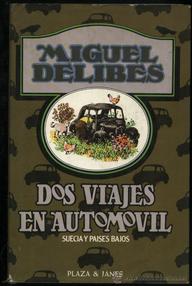
Other works
of Miguel Delibes
La censura de prensa en los años 40 (y otros ensayos) (Press censorship during the fourties and other essays)
Ámbito, 1985
Miguel Delibes Delibes offers in this work a series of reflections- a total of 10 brief essays- about literary creation: from the freedom status to write to a personal analysis of the tendencies, works and authors of the universal literature. The first of these essays talks about Delibes´experience as a journalist for El Norte de Castilla during the first years of the dictatorship of Franco.
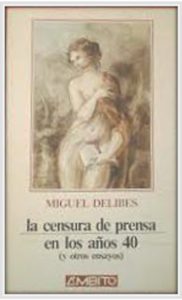
Castilla habla (Castille speaks)
Destino, 1986
These are thirtytwo talks with who still have old rural jobs that are about to disappear in Castilla. The protagonists talk with their own voices here and thus we see how the land of Castilla talks throughout their voices.
“The apparently simple voices of a shepherd, a snail picker, a miller, a pinecone picker, apart of their expression richness that I tried to keep intact, frequently point out the old problems of Catilla y León: drought, soil poverty, isolation, depopulation, population growing old, pollution, mistrust… all those issues show how a region that was powerful and rich, now is rather abandoned and with a precarious connection and communication system”.
Miguel Delibes underlines that this book is not a novel but neither a scientific survey supported by data and figures, it could be considered a living portrait of the Castillian reality shown by its real protagonists the people from its villages and towns”.
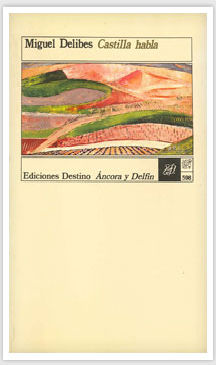
Pegar la hebra (Talk nineteen to the dozen)
Destino, 1990
In this work Miguel Delibes intends to chat extensively with his readers about random and diverse topics. With his natural mastery in the use of language, Delibes invites his readers to get to know his days as a journalist under the oppression of the censorship during the fourties, about his ideas related to ecology and hunting, about abortion and progress, about football and violence or about cinema and literature, his anecdotes when dealing with Joaquín Garrigues or Francisco de Cossío, among some other public figures.
“Pegar la hebra” offers a collection of memories, opinions and characters, as well as a self-portrait of a humanist as Delibes was that contemplates the world and offers it in these pages.
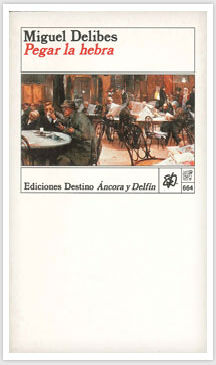
He dicho (I said so)
Destino, 1996
«He dicho» is a miscellaneous collection of works-articles, notes, talks, discourse, personal notes…- about several topics but very characteristic from Delibes´ world.
This work is divides in six chapters- “La tierra y sus pobladores”, “Mundos de papel”, “El cine cumple un siglo”, “Adiós a los amigos”, “Las cosas de la vida” and “Una vida vivida”- in these chapters the writer talks about the Spanish farmers situation in the European Union or the desertification process in Castilla, at the same time he insists on his recurrent worries or evoques memories of his trips, tributes of dear friends- as Félix Rodríguez de la Fuente- Literary opinions or about cinema, hunting chronicles…- The last of the chapters reproduces the discourse that the writer gave with the acceptance of the “Miguel de Cervantes Award” ceremony.
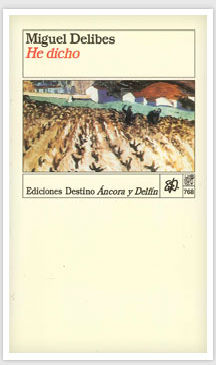
España 1936-1950: Muerte y resurrección de la novela (Spain 1936-1950: Death and resurrection of the novel)
Destino, 2004
In this work Miguel Delibes offers and overview of the literay generation to which he belongs to and that is the witness, after the Civil War,of the resurrection of the novel in Spain, in a time that is represented by the difficulties but nevertheless a time of a rich narrative production.
The book is formed by two block of texts. The first one is conformed by the notesthat Delibes took during the conferences that he offered during the fifties in Argentina and Chile and in the beginning of the sixties in The United States. The second block contains four conferences that talk about the narration processes: “La creación literaria”, “El novelista y sus personajes”, “Novela de posguerra (1940-2000) and “Confidencia”.
